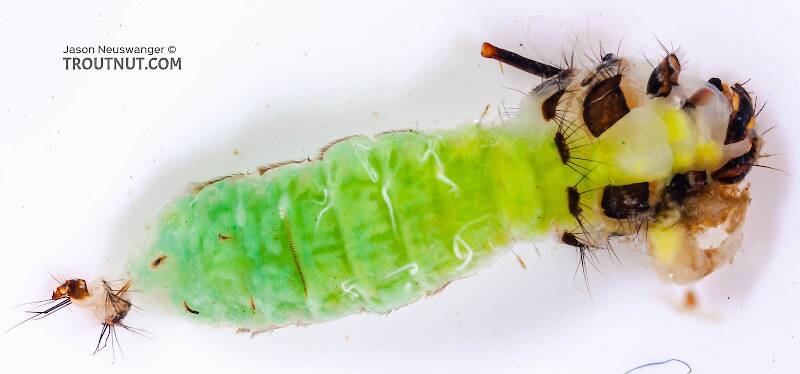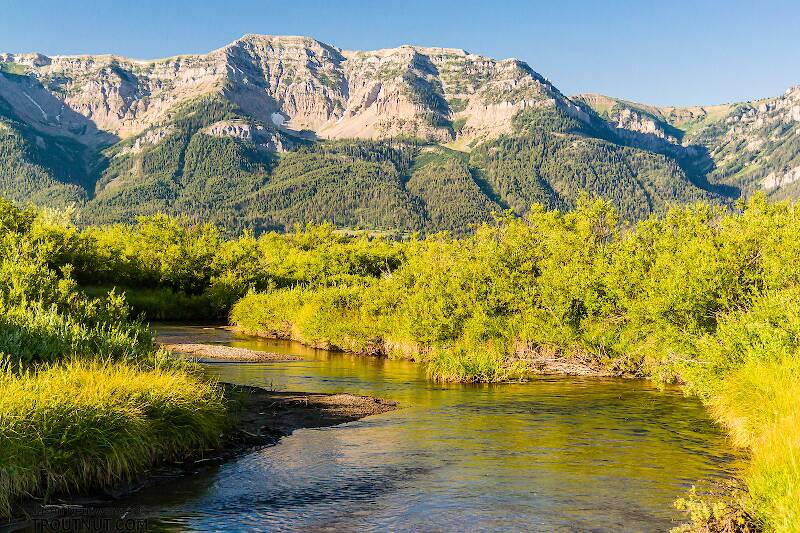
Blue-winged Olives
Baetis
Tiny Baetis mayflies are perhaps the most commonly encountered and imitated by anglers on all American trout streams due to their great abundance, widespread distribution, and trout-friendly emergence habits.
Featured on the forum

With a bit of help from the microscope, this specimen keys clearly and unsurprisingly to Hydropsyche.

Troutnut is a project started in 2003 by salmonid ecologist Jason "Troutnut" Neuswanger to help anglers and
fly tyers unabashedly embrace the entomological side of the sport. Learn more about Troutnut or
support the project for an enhanced experience here.

The green blob contained in this case is a pupa in the early stages of transformation from larva to the final stage we generally picture and imitate. This specimen and several like it were fixed to a rock I picked up, and each one had the front of its case sealed off, protecting the helpless pupa from predation. It's neat to see the insect part-way through such a radical transformation.
It was very hard to extract this thing from its case, so there's a bit of extra goo near the head from where I accidentally punctured it.
It was very hard to extract this thing from its case, so there's a bit of extra goo near the head from where I accidentally punctured it.
Martinlf on Apr 26, 2009April 26th, 2009, 2:54 am EDT
One of our brethren recently noted some olive caddis hatching during a dark Grannom emergence on a central PA stream. Pondering this, and not knowing much about caddis, I began to wonder if the olive bodied bugs might be Grannoms as well, either in a different color phase, or one gender, such as females with egg masses coloring the abdomen some. Am I too far off?
"He spread them a yard and a half. 'And every one that got away is this big.'"
--Fred Chappell
--Fred Chappell
LittleJ on Apr 26, 2009April 26th, 2009, 3:03 pm EDT
I'll try and give this a head start. The best I can come up with is Ceratopsyche. The newly emerged pic looks pretty accurate. The obvious answer would be apple caddis but it def. is not. The pics are too bright. It was also to early in the day to see the females w/ egg sacs. I also noted the ginger shucks which cancels out the grannoms as well. Hopefully someone can run with this because i've been wondering what color the larva is.... green/olive always and have been working, but there is so much in the water right know it's hard to say what they are take it for.
jeff
jeff
GONZO on Apr 27, 2009April 27th, 2009, 2:51 am EDT
That's a very good possibility, Jeff. Hydropsyche/Ceratopsyche species are especially prominent during the seasonal "mayfly lull." On most Northeastern streams, after the early season Blue Quill, Quill Gordon, and Hendrickson hatches wind down, caddisflies become the main hatching activity until the first of the large early Sulphurs appear.
On the J, I would expect that Hydropsyche/Ceratopsyche species comprise some of most important hatches as the Grannoms decline. I often see fly shops posting "olive caddis" on their hatch boards from now through the first weeks of May, and I believe it refers to one of the Hydropsyche/Ceratopsyche species--probably C. bronta. Here's Gary LaFontaine's description of the timing of bronta:
The current heatwave is forcing earlier emergence. I had hoped to get to the Poconos for the Hendrickson hatch (which typically peaks as April breaks into May on the larger streams up there), but the heat blew most of them out in a two-day blitz. They are already on the wane. Now, I'm preparing for Hydropsyche/Ceratopsyche hatches.
Although imitations that generally suggest the larvae can be broadly useful as searching patterns, the larvae will be holed up in temporary pupation shelters prior to emergence, so I wouldn't worry about specific larval imitations around the time of emergence. I would focus on imitating the pupae. The female bronta pupae are typically #14-16 with yellowish abdomens, and the males are #16-18 and more greenish (bright "olive"). (However, several H/C species emerge at this time, so a more tannish or brownish yellow pupa can also be useful.)
On the J, I would expect that Hydropsyche/Ceratopsyche species comprise some of most important hatches as the Grannoms decline. I often see fly shops posting "olive caddis" on their hatch boards from now through the first weeks of May, and I believe it refers to one of the Hydropsyche/Ceratopsyche species--probably C. bronta. Here's Gary LaFontaine's description of the timing of bronta:
The peak of emergence seems to occur just as the weather turns nice for the season in whatever region it is in.
The current heatwave is forcing earlier emergence. I had hoped to get to the Poconos for the Hendrickson hatch (which typically peaks as April breaks into May on the larger streams up there), but the heat blew most of them out in a two-day blitz. They are already on the wane. Now, I'm preparing for Hydropsyche/Ceratopsyche hatches.
Although imitations that generally suggest the larvae can be broadly useful as searching patterns, the larvae will be holed up in temporary pupation shelters prior to emergence, so I wouldn't worry about specific larval imitations around the time of emergence. I would focus on imitating the pupae. The female bronta pupae are typically #14-16 with yellowish abdomens, and the males are #16-18 and more greenish (bright "olive"). (However, several H/C species emerge at this time, so a more tannish or brownish yellow pupa can also be useful.)
Martinlf on Apr 28, 2009April 28th, 2009, 2:32 pm EDT
Jeff, what was the size on those bugs? I should have started there with my questions. It appears that my wild guess was off, but that's how I learn. Thanks for weighing in with Gonzo here. But now I have to carry another fly next time the Grannoms are coming off!
"He spread them a yard and a half. 'And every one that got away is this big.'"
--Fred Chappell
--Fred Chappell
LittleJ on Apr 28, 2009April 28th, 2009, 3:31 pm EDT
louis,
14's, but I'd carry some 16's as well. Alan At Spruce creek outfitters uses caddis green wapsi dub. It seemed a bit bright to me and I think I'll tone it down a bit next year with a little olive blended in. However I doubt it matters much because I've caught fish on both dark olive and the bright caddis green. I think the fish are just keying on something down winged that isn't black or dark brown.
jeff
14's, but I'd carry some 16's as well. Alan At Spruce creek outfitters uses caddis green wapsi dub. It seemed a bit bright to me and I think I'll tone it down a bit next year with a little olive blended in. However I doubt it matters much because I've caught fish on both dark olive and the bright caddis green. I think the fish are just keying on something down winged that isn't black or dark brown.
jeff
Creno on Apr 29, 2009April 29th, 2009, 3:02 pm EDT
Gonzo -
In your comment above you reference Hydropsyche/Ceratopsyche. Is that because you are lumping the two or that you actually see both "groups" at the same time? I have been looking at alot of caddis from the Adirondack area and I seldom see both taxa together. Almost everything is "Ceratopsyche." I was wondering if you see many non-Ceratopsyche in the colder trout streams?
Creno
In your comment above you reference Hydropsyche/Ceratopsyche. Is that because you are lumping the two or that you actually see both "groups" at the same time? I have been looking at alot of caddis from the Adirondack area and I seldom see both taxa together. Almost everything is "Ceratopsyche." I was wondering if you see many non-Ceratopsyche in the colder trout streams?
Creno
GONZO on Apr 29, 2009April 29th, 2009, 3:39 pm EDT
Creno, I was just recognizing that there still seems to be lingering debate about whether Ceratopsyche should be considered as a genus or subgenus. I'll leave that to those who are qualified to sort it out. I just try to deal with taxonomic revisions as best I can. :)
However, the species involved in our "mayfly lull" emergence seem to be "Ceratopsyche" species like bronta, sparna, and slossonae. (But don't quote me on that, because I always reserve the right to be wrong.)
However, the species involved in our "mayfly lull" emergence seem to be "Ceratopsyche" species like bronta, sparna, and slossonae. (But don't quote me on that, because I always reserve the right to be wrong.)
Martinlf on Jan 8, 2013January 8th, 2013, 2:41 pm EST
Any ideas on when Grannoms might get started on Penns Creek this coming spring? It looks like another warm winter. Did anyone fish this hatch there last year?
"He spread them a yard and a half. 'And every one that got away is this big.'"
--Fred Chappell
--Fred Chappell
Quick Reply
Related Discussions
Topic
Replies
Last Reply


